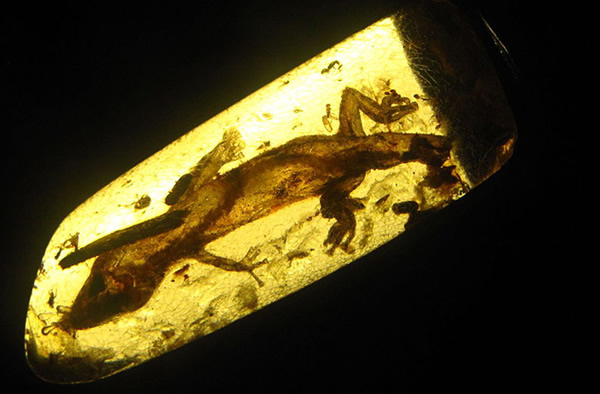Low Oxygen Dino Air Trapped in Amber
Amber may not preserve dino DNA, as in Jurassic Park, but the fossilized tree sap did trap clues about the air the extinct beasts breathed. Amber analysis revealed that dinosaurs inhaled air with far less oxygen than the modern atmosphere holds.
Mineralogists recently examined the chemical composition of 538 samples of amber and tree resins dating from the current Quaternary period to as far back as the Triassic period, 220 million years ago, when dinos were first staking their claim on the planet. The Quaternary period is the present stage of the Earth’s development, which includes the Ice Ages and the whole of human history.
Nowadays in the Quaternary, humans fill their lungs with air containing approximately 21 percent oxygen. However, amber from the dinosaurs’ time holds chemical clues that the dinos breathed in only 10 to 15 percent oxygen air.
Previous studies in Nature and the Proceedings of the National Academy of Sciences suggested that high oxygen levels fueled the evolution of giant insects and other lifeforms. However, the new amber study’s results suggest oxygen levels didn’t super-charge dino’s ability to grow to tremendous sizes.
“We do not want to negate the influence of oxygen for the evolution of life in general with our study, but the gigantism of dinosaurs cannot be explained by those theories,” said Ralf Tappert of the University of Innsbruck and lead author of the amber study, published in the journal Geochimica et Cosmochimica Acta, in a press release.
Amber and non-fossilized tree resins trapped a record of changing oxygen levels because sap-oozing trees intake of carbon dioxide changed depending on oxygen concentration. When oxygen levels changed, the trees collected different amounts of a form of carbon, an isotope known as carbon-13.
During the dinosaur era, volcanic activity may have increased the amount of carbon dioxide in the air. This increased the greenhouse effect, which subsequently increased oxidative weathering, or the amount of oxygen bound to other chemicals during the weathering of rocks, according to the study.
IMAGE: Oligocene-era gecko trapped in amber. (PG Palmer, Wikimedia Commons)(Nov 20, 2013 06:32 AM ET // by Tim Wall)












